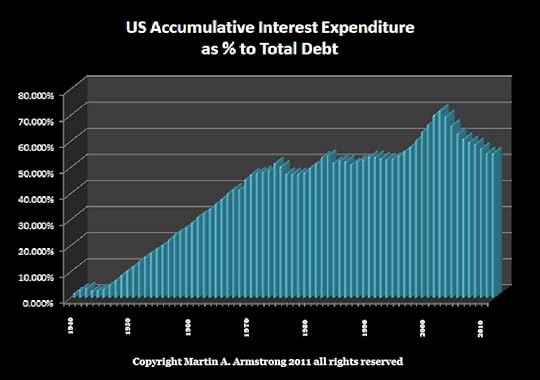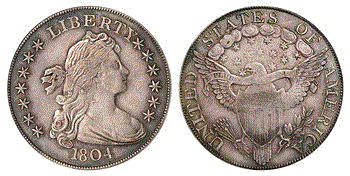Steve Bull's Blog, page 1212
January 24, 2018
Trump Officially Restores Cold War

Trump Officially Restores Cold War
On January 20th, CBS News bannered “Terrorism no longer the military’s top priority, Mattis says” and opened: “There is a major change in US military strategy. On Friday, more than 16 years after the 9/11 attacks, US Defense Secretary Jim Mattis said terrorism is no longer the No. 1 priority.” The report said, “Maintaining a military advantage over China and Russia is now Defense Secretary Mattis’ top priority.”
On January 18th, the Trump Administration had issued its crucial document about how it will implement America’s national defense from now on. This document, the National Defense Strategy 2018, represents a continuation of US President Barack Obama’s vision and intentions, but extends Obama’s hostility toward Russia, by adding Trump’s hostility toward China.
In December 2017, US President Donald Trump had issued his National Security Strategy 2018 (the NSS2018); but, in keeping with his prior commitment to leaving to the generals the implementation of his national security policy, the Pentagon has now issued this National Defense Strategy 2018 (the NDS2018), which is signed only by Trump’s minister for war (Secretary of ‘Defense’), “Jim Mattis”; and it’s considerably more informative on what the practical meaning of NSS2018 will be. The meaning is: the replacement of hostility against “radical Islamic terrorism,” by hostility against Russia and China — this, the building upon Obama’s imperial vision, is now Trump’s ‘Defense’ policy. Trump’s campaign talk against ‘radical Islamic terrorism’ was merely bumper-sticker stuff, to win votes.
In continuation from Obama’s National Security Strategy 2015, which had accused Russia 18 times of “aggression,” Trump’s National Defense Strategy 2018 (NDS2018) effectively declares at least an economic war against Russia (as if economics were also in General Mattis’s portfolio), but it goes even further to include China as being now also America’s enemy.
…click on the above link to read the rest of the article…
Can We Stop the Government Borrowing & Just Print Without Inflation?
The conservatives are going nuts about raising the debt ceiling as if this really matters. They claim: “The United States is effectively bankrupt, but that doesn’t matter to the GOP. Once evangelists of fiscal responsibility and scourges of deficit spending, Republicans today glory in spilling red ink. The national debt is now $20.6 trillion, greater than the annual GDP of about $19.5 trillion. Alas, with Republicans at the helm, deficits are set to continue racing upwards, apparently without end.”
What they fail completely to grasp here is until the system is completely revamped and we adopt the way the Roman Empire was funded from 280BC to 68AD, just creating the money to fund the government instead of borrowing it, there is no hope in solving this issue. In a recession, Keynes argued borrowing can be beneficial in creating economic stimulus and shortening the recession. Governments used that statement to then perpetually borrow year after year.
In 1940 a Cadillac sold for $1675. Currently, the low-end Cadillac is $35,000. This is almost 21 times the 1940 price level. The US national debt was $51 billion before the war and it is now $20 trillion. The debt has risen 392% compared to 20.89% for a Cadillac. The minimum wage in 1940 was 30 cents per hour. Today, the minimum wage is $10.10 per hour in 2018, which is a rise of 33.6%. However, if we look at collectibles, the famous 1804 silver dollar sold for $30,000 around 1940. In 1999, one sold for $4.14 million. Here we had an advance of 138%.
 Then there was the Peter Paul Rubenswhich just sold for $58 million in 2016. The owners had tried to sell during the Great Depression. Nobody was interested. They then lent to a monastery where it hung in a hallway for 20 years. Other than that exception, nothing has advanced in proportion to the national debt.
Then there was the Peter Paul Rubenswhich just sold for $58 million in 2016. The owners had tried to sell during the Great Depression. Nobody was interested. They then lent to a monastery where it hung in a hallway for 20 years. Other than that exception, nothing has advanced in proportion to the national debt.
…click on the above link to read the rest of the article…
Is “Fake News” Really Fake?
The more complicated a situation, the more open to interpretation it is.
The term “fake news” has been much in the news since the 2016 election. Unfortunately, it is not usually defined in any clear fashion. The implication is that the media engages in deliberate distortion and misrepresentation of the news. Not just any media, but most of the media, commonly referred to as the “mainstream media,” have been accused of distributing “fake news.”
Recently, I read an extended critique of the media that put everything in quite a different light. It is something I believe every working journalist should read. Sixty short pages that explain that not only is there a distinct bias in the mainstream media, but why this is the case. What is of most importance to note is that this bias is not deliberate. It exists on a subconscious level and influences everything the media does. And it does not matter whether the particular media outlet has a left or a right slant.
The author, Robin Koerner, has a masters degree in the philosophy of science and physics from Cambridge. The information is in the first chapter of his book If You Can Keep It: Why We Nearly Lost It & How We Get It Back, a chapter he calls “Mediography.”
Bias Exists Within All of Us
A paradigm is a framework within which someone observes and comments on the world.
The best way to explain the points he makes is to start with an example. Here is a headline from the Drudge Report dated November 2006: “Iran Fires Missile That Can Reach Israel.” The headline is factually accurate. It is not deliberately biased. But, Koerner argues, it is misleading. It could be considered fake news (though Koerner does not use those terms)….click on the above link to read the rest of the article…
A National Defense Strategy of Sowing Global Chaos
In the new U.S. National Defense Strategy, military planners bemoan the erosion of the U.S.’s “competitive edge,” but the reality is that they are strategizing to maintain the American Empire in a chaotic world, explains Nicolas J.S. Davies.
Presenting the 2018 National Defense Strategy of the United States on Friday at the Johns Hopkins University, Secretary of Defense James Mattis painted a picture of a dangerous world in which U.S. power – and all of the supposed “good” that it does around the world – is on the decline.
“Our competitive edge has eroded in every domain of warfare – air, land, sea, space, and cyberspace,” he said. “And it is continually eroding.”
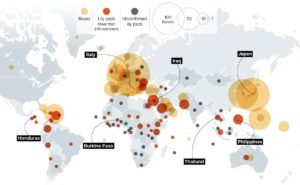
Known locations of U.S. military bases around the world (Source: Politico)
What he could have said instead is that the United States military is overextended in every domain, and that much of the chaos seen around the world is the direct result of past and current military adventurism. Further, he could have acknowledged, perhaps, that the erosion of U.S. influence has been the result of a series of self-inflicted blows to American credibility through foreign policy disasters such as the 2003 invasion of Iraq.
There were also two important words hidden between the lines, but never mentioned by name, in the new U.S. National Defense Strategy: “empire” and “imperialism.”
It has long been taboo for U.S. officials and corporate media to speak of U.S. foreign policy as “imperialism,” or of the U.S.’s global military occupations and network of hundreds of military bases as an “empire.” These words are on a long-standing blacklist of “banned topics” that U.S. official statements and mainstream U.S. media reports must never mention.
…click on the above link to read the rest of the article…
January 6, 2018
Eleven Saudi Royals Arrested For Protesting Against Austerity
Members of Saudi Arabia’s royal family have apparently learned nothing from their cousin’s authoritarian tendencies. To wit, Saudi authorities on Saturday detained 11 princes after they gathered at a royal palace in Riyadh to protest austerity measures imposed by their cousin and the state’s de facto leader: Crown Prince Mohammad bin Salman, aka MbS.
Crown Prince Mohammad bin Salman
As part of the latest wave of cutbacks forced by still-low oil prices, bin Salman suspended payment of royals’ utility bills. The decision triggered a backlash among the royals who weren’t prosecuted during the Crown Prince’s “corruption crackdown”/cash grab from late last year, and they swiftly assembled at the Qasr a-Hokm, a historic royal palace, to demand the cancellation of a royal decree that stopped state payment of water and electricity bills for royal family members. The move was a rare act of defiance against the Saudi crown, per Reuters. They were also demanding compensation for a death sentence issued against a relative, local media reported.
In light of recent “events” in Saudi Arabia, it was a rather poor decision.
The identities of the princes taken into custody have not been released. However, the leader of the group has been identified by the initials S.A.S.”Everybody is equal before the law and anyone who does not implement regulations and instructions will be held accountable, no matter who he is,” a local media website added.
Late last year, MbS imprisoned dozens of royals at the Riyadh Ritz Carlton until they agreed to fork over substantial chunks of their wealth in exchange for their freedom. The shakedown resulted in one former general being tortured to death after refusing to give in to MbS’s remunerative demands – the princes spoke up, and were promptly taken into custody.
…click on the above link to read the rest of the article…
End of ‘free’ press? NYT caved in to Bush & Obama, held NSA bombshell for 1 yr – James Risen
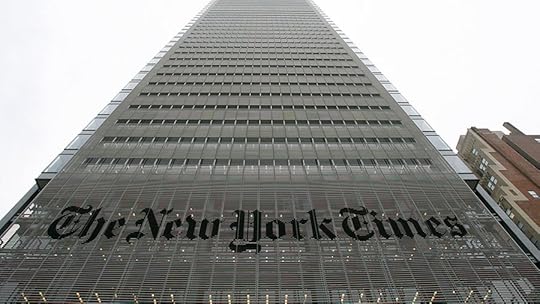
© Gary Hershorn / Reuters
The New York Times was “quite willing” to quash stories at the behest of the government, writes Pulitzer Prize-winning reporter James Risen. He warns that America’s press has been muzzled by “hyped threats” to national security.
In an in-depth retelling of his experience as a national security reporter for the New York Times (NYT), published in The Intercept, Risen explains how, on more than one occasion, the NYT yielded to government demands to withhold or kill his stories – including a bombshell report about the NSA’s secret surveillance program under President George W. Bush.
Jaded by previous experiences of US government interference in his work, Risen writes that his NSA story set him on a “collision course” with his editors, “who were still quite willing to cooperate with the government.” His editors at the Times had been convinced by top US officials that revealing the illegal surveillance program would endanger American lives, Risen said.
Bill Keller, the then executive editor of Times, said the newspaper’s decision to shelve the explosive report, which detailed how the NSA had “monitored the international telephone calls and international e-mail messages of hundreds, perhaps thousands, of people inside the United States without warrants over the past three years,” was motivated by the lingering “trauma” of the 9/11 terror attacks, and the sobering reality that the “world was a dangerous place.”
Risen’s NSA scoop, which later won him a Pulitzer Prize, was eventually published a year after he submitted it to his seniors – but only after Bush had been safely re-elected. Risen said that upon hearing the story was finally going to print, Bush telephoned Arthur Sulzberger, the Times’s publisher, requesting a private meeting to convince him against running the story.
…click on the above link to read the rest of the article…
Censorship “Is The Cause Of Every Revolution In Human History”
In response to a question about stopping “fake news”, Edward Snowden notes:
Censorship does not do good. We might want to believe it does, and this gets into the fake news problem, for example, that if we just empower Facebook to decide what we can and can’t see and what is good and bad, the problem can be solved. But this is a mistake for a number of reasons.
One, it creates a slippery slope where now we have private corporations deciding what can and cannot be said. But further, let’s say there are clear cases, we’re talking about things like Jihadist propaganda, we’re talking about fascist communities that are promoting ideas that are actively harmful, out in the public. The problem is, if you censor them, you don’t actually remove them. You don’t stop the idea from being spread. You just force them underground. It is underground where these ideas actually propagate best and most effectively. This idea that we can just stamp out ideas, we know does not work. This is the cause of every revolution in human history.
President Kennedy agreed:
Those who make peaceful revolution impossible will make violent revolution inevitable.
Indeed, the American government is doing what King George did before the American Revolution … trying to crush dissent.
Iran Claims It Has “Hard Evidence” Of Foreign Meddling In Protests
Friday’s UN Security Council meeting didn’t disappoint in terms of the anticipated level of inflammatory rhetoric and accusations. Also not unexpected is that the US finds itself isolated after a week of the Trump White House going on the offensive: first by essentially calling for regime change in Iran after the onset of mass protests last week (the State Dept.’s first statement a week ago referenced “transition of government”), and then came the bombshell announcement that all foreign aid to Pakistan, which reportedly totals up to $2 billion in promised security aid, has been cut.
And not helpful to any of this was Trump’s lashing out through a series off the cuff tweets aimed at Iran and Pakistan in the past days – some of which may have precipitated Pakistan’s finally pulling the trigger on ditching the dollar in trade with China in retaliation.
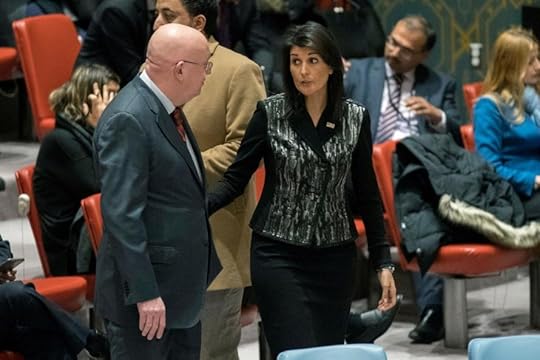
Image via the AP
These countries and others came out swinging at the UN. First, Iran’s ambassador told the meeting that his government has “hard evidence” that recent protests in Iran were “very clearly directed from abroad.”
According to the Washington Post, Iran’s highest legal authority previously claimed direct CIA involvement in the unrest which has now taken over two dozen lives, including at least one police officer and three Iranian intelligence officers who were reported killed during clashes in the western city of Piranshahr on Wednesday. The Washington Post summarized the allegations as follows:
Iran’s prosecutor general, Mohammad Jafar Montazeri, alleged Thursday that an American CIA official was the “main designer” of the demonstrations. And Iranian Ambassador Gholamali Khoshroo – whose country isn’t a Security Council member but was invited to participate Friday – said the protests had gotten “direct encouragement by foreign forces including by the president of the United States.”
…click on the above link to read the rest of the article…
U.S. Gold Market Switches From A Surplus In 2016 To Deficit In 2017
The U.S. gold market suffered a net deficit this year compared to a small surplus in 2016. This was quite interesting because U.S. physical gold demand will be down considerably this year. In 2016, total U.S. gold demand was 212 metric tons versus an estimated 150 metric tons this year. The majority of the decline in U.S. gold demand is from the physical bar and coin sector that is down 56% in the first three quarters of 2017 compared to the same period last year.
So, why will the U.S. gold market suffer a deficit if gold demand is down sharply this year? Well, it seems as if the culprit is the huge increase in net gold exports. Last year, the U.S. imported 374 metric tons (mt) of gold and exported 398 mt for a net 24 mt deficit. However, this year, estimates for U.S. gold imports will fall to 250 mt while exports increase to 475 mt. Thus, the U.S. net export deficit will be 225 mt in 2017:
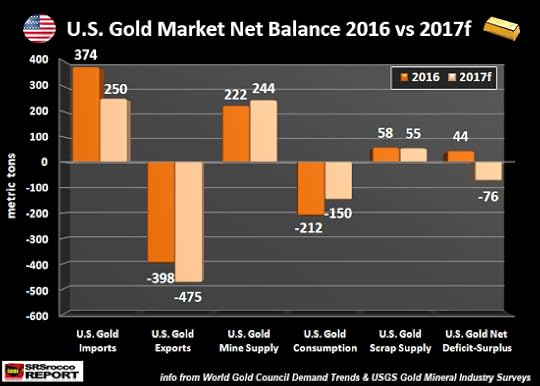
However, if we look at all the data in the chart above, the U.S. gold market will experience a net 76 mt deficit in 2017 versus a 44 mt surplus last year (bars right-hand side of chart). Again, we can see that U.S. gold imports are estimated to decline significantly this year to 250 mt compared to 374 mt in 2016. Furthermore, total U.S. gold exports are forecasted to increase to 475 mt this year versus 398 mt in 2016.
When we factor in U.S. gold mine supply, domestic consumption, and gold scrap supply, the market will go from a small 44 mt surplus in 2016 to a 76 net deficit this year.
…click on the above link to read the rest of the article…
6 Critical Tips You Need to Know In Order To Survive Being Stranded in Your Car in Freezing Temperatures
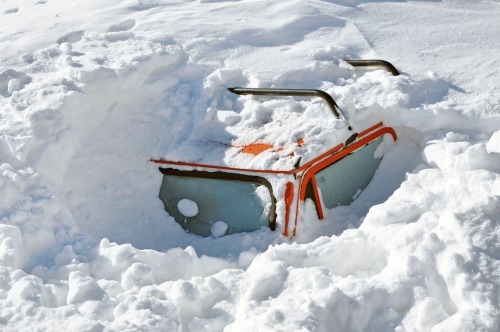 With the unusual winter weather that many parts of the country are experiencing, driving conditions will be harsh and potentially dangerous. Moreover, getting stranded in your vehicle could become a very real threat, especially if you are traveling in isolated parts of the country. If this happens, you have a potentially dangerous survival situation on your hands.
With the unusual winter weather that many parts of the country are experiencing, driving conditions will be harsh and potentially dangerous. Moreover, getting stranded in your vehicle could become a very real threat, especially if you are traveling in isolated parts of the country. If this happens, you have a potentially dangerous survival situation on your hands.
Most people’s instinct will tell them to leave the car and go for help. If you are in a desolate area, you may not know how far help is and leaving your car will expose you and could get you lost in the wilderness if you don’t know where you are going.
6 Critical Tips You Need to Know In Order To Survive Being Stranded in Your Car in Freezing Temperatures
OK, let’s put your survival know-how to the test. Here’s the scenario:
At 3 p.m., a last minute work order has requested you to deliver some equipment but you must drive through a remote area where the road’s elevation is between 4,000 and 4,500 feet. The road is infamous for people who don’t know the area to take in the wintertime and get stuck, but you’ve driven it a few times and feel confident you can make it before dark. Before you set out, you turn on your GPS on your cell phone just in case. You’ve also checked the weather station, which turns out is calling for unexpected snow flurries in the area, but you’re on a deadline and will drive very carefully.
…click on the above link to read the rest of the article…

